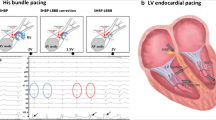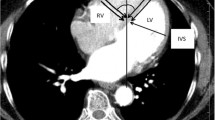Abstract
Purpose
Bifocal pacing in the right ventricle is an option for patients with end-stage heart failure in whom biventricular pacing is not possible, due to failure in left ventricular (LV) lead insertion. The purpose of this prospective study was to document the clinical response of these patients, after bifocal pacing.
Methods
From the patients referred for cardiac resynchronization therapy (CRT), from 2009 to 2010, 13 cardiac CRT candidates who underwent unsuccessful LV lead implantation were included. The bifocal system’s leads were implanted in the right atrium, the right ventricular (RV) apex, and the RV outflow tract. Initial patient assessment and follow-up evaluation after 6 months included clinical criteria, echocardiographic indices, and biochemical parameters.
Results
From 13 patients (age 68 ± 9 years, nine male), 10 improved clinically. New York Heart Association classification was reduced by one grade (from 3.6 ± 0.5 to 2.8 ± 0.8, p < 0.005 and respectively), while hospitalizations in 6-month time were reduced from three to one (p < 0.001). Six-minute walk test (in meters) increased from 176 ± 86 to 297 ± 91 (p < 0.001) and quality of life improved (EQ-VAS scale changed from 42 ± 12.5 % to 70.8 ± 20.3 %, p < 0.001). Mean shortening in QRS duration was 31.3 ms (from 165.1 ± 16.3 to 133.8 ± 12.7, p < 0.001) and B-type natriuretic peptide (in picograms per milliliter) dropped from 834 ± 350 to 621 ± 283 (p < 0.001). Ejection fraction (in percent) increased from 27.5 ± 4.6 to 33.3 ± 4.4 (p < 0.001), and mitral regurgitation severity decreased by one grade (from 2.7 ± 0.9 to 1.8 ± 0.7, p < 0.05).
Conclusion
RV bifocal pacing seems to offer a substantial clinical benefit to heart failure patients with traditional CRT indications and could be an alternative option when LV access is unsuccessful.
Similar content being viewed by others
References
Abraham, W. T. (2003). Cardiac resynchronization therapy: A review of clinical trials and criteria for identifying the appropriate patient. Reviews in Cardiovascular Medicine, 4, S30–S37.
Abraham, W., & Hayes, D. (2003). Cardiac resynchronization therapy for heart failure Circulation, 108, 2596–2603.
Siddique, A., & Salman, M. (2008). Cardiac resynchronization therapy. University Heart Journal, 4, 2.
Abraham, W. T., Fisher, W. G., Smith, A. L., Delurgio, D. B., Leon, A. R., Loh, E., Kocovic, D. Z., et al. (2002). Cardiac resynchronization in chronic heart failure. The New England Journal of Medicine, 346, 1845–1853.
Cazeau, S., LeClerq, C., Lavergne, T., Walker, S., Varma, C., Linde, C., Garrigue, S., et al. (2001). Effects of multisite biventricular pacing in patients with heart failure and intraventricular conduction delay. The New England Journal of Medicine, 344, 873–880.
Linde, C., Leclerq, C., Rex, S., Garrigue, S., Lavergne, T., Cazeau, S., McKenna, W., et al. (2002). Long-term benefits of biventricular pacing in congestive heart failure: Results from the multisite stimulation in cardiomyopathy (MUSTIC) study. Journal of the American College of Cardiology, 39, 2026–2033.
Bristow, M. R., Feldman, A. M., & Saxon, L. A. (2000). Heart failure management using implantable devices for ventricular resynchronization: Comparison of medical therapy, pacing, and defibrillation in chronic heart failure (COMPANION) trial. Companion Steering Committee and Companion Clinical Investigators. Journal of Cardiac Failure, 6, 276–285.
Khaykin, Y., Saad, E. B., & Wilkoff, B. L. (2003). Pacing in heart failure: The benefit of resynchronization. Cleveland Clinic Journal of Medicine, 70, 841–866.
Kerwin, W. F., Botvinick, E. H., O’Connel, J. W., Merrick, S. H., DeMarco, T., Chatterjee, K., Scheibly, K., et al. (2000). Ventricular contraction abnormalities in dilated cardiomyopathy: Effect of biventricular pacing to correct interventricular dyssynchrony. Journal of the American College of Cardiology, 35, 1221–1227.
Nelson, G. S., Berger, R. D., Fetics, B. J., Talbot, M., Spinelli, J. C., Hare, J. M., Kass, D. A., et al. (2000). Left ventricular or biventricular pacing improves cardiac function at diminished energy cost in patients with dilated cardiomyopathy and left bundle-branch block. Circulation, 102, 3053–3059.
Cleland, J. G., Daubert, J. C., Erdmann, E., Freemantle, N., Gras, D., Kappenberger, L., & Tavazzi, L. (2005). Cardiac Resynchronization-Heart Failure (CARE-HF) Study Investigators. The effect of cardiac resynchronization on morbidity and mortality in heart failure. The New England Journal of Medicine, 352, 1539–1549.
Daoud, E. G., Kalbfleisch, S. J., Hummel, J. D., Weiss, R., Augustini, R. S., Duff, S. B., Polsinelli, G., et al. (2002). Implantation techniques and chronic lead parameters of biventricular pacing dual-chamber defibrillators. Journal of Cardiovascular Electrophysiology, 13, 964–970.
Leon, A. R., Abraham, W. T., Curtis, A. B., Daubert, J. P., Fisher, W. G., Gurley, J., Hayes, D. L., et al. (2005). MIRACLE Study Program. Safety of transvenous cardiac resynchronization system implantation in patients with chronic heart failure: Combined results of over 2,000 patients from a multicenter study program. Journal of the American College of Cardiology, 46, 2348–2356.
Beshai, J. F., Grimm, R. A., Nagueh, S. F., et al. (2007). Cardiac-resynchronization therapy in heart failure with narrow QRS complexes. The New England Journal of Medicine, 357, 2461–2471.
Linde, C., Abraham, W. T., Gold, M. R., Stjohn, S. M., Ghio, S., & Daubert, C. (2008). Randomized trial of cardiac resynchronization in mildly symptomatic heart failure patients and in asymptomatic patients with left ventricular dysfunction and previous heart failure symptoms. Journal of the American College of Cardiology, 52, 1834–1843.
Moss, A. J., Hall, W. J., Cannom, D. S., et al. (2009). Cardiac-resynchronization therapy for the prevention of heart-failure events. The New England Journal of Medicine, 361, 1329–1338.
Gras, D., Bocker, D., Lunati, M., et al. (2007). Implantation of cardiac resynchronization therapy systems in the CARE-HF trial: Procedural success rate and safety. Europace, 9, 516–522.
Vlay, S. C. (2004). Alternate site biventricular pacing: Bi-V in the RV—is there a role? Pacing and Clinical Electrophysiology, 27(5), 567–569.
Res, J. C., Bokern, M. J., de Cock, C. C., van Loenhout, T., Bronzwaer, P. N., Spierenburg, H. A., & BRIGHT Investigators. (2007). The BRIGHT study: Bifocal right ventricular resynchronization therapy: A randomized study. Europace, 9(10), 857–861. Epub 2007 Aug 7.
Barold, S. S., Audoglio, R., Ravazzi, P. A., & Diotallevi, P. (2008). Is bifocal right ventricular pacing a viable form of cardiac resynchronization? Pacing and Clinical Electrophysiology, 31(7), 789–794.
Dickstein, K., Vardas, P., Auricchio, A., Daubert, J. C., Linde, C., McMurray, J., Polikowski, P., Priori, S. G., Sutton, R., & Veldhuisen, D. (2010). 2010 Focused update of ESC Guidelines on device therapy in heart failure. European Heart Journal, 31, 2677–2687.
O’Donnell, D., Nadurata, V., Hamer, A., Kertes, P., & Mohamed, U. (2005). Bifocal right ventricular cardiac resynchronization therapies in patients with unsuccessful percutaneous lateral left ventricular venous access. Pacing and Clinical Electrophysiology, 28(Suppl 1), S27–S30.
EuroQol Group. EQ-5D™ is a standardised instrument for use as a measure of health outcome. Available at http://www.euroqol.org/
American Thoracic Society (2002). “ATS Statement: Guidelines for the six-minute walk test” Available at www.thoracic.org/statements/resources/pfet/sixminute.pdf
Mond, H., Hillock, R., Stevenson, I., & Gavigan, A. (2007). The right ventricular outflow tract: The road to septal pacing. Pacing and Clinical Electrophysiology, 30, 482–491.
Pachón, J. C., Pachón, E. I., Albornoz, R. N., Pachón, J. C., Kormann, D. S., Gimenes, V. M., Medeiros, P. T., et al. (2001). Ventricular endocardial right bifocal stimulation in the treatment of severe dilated cardiomyopathy heart failure with wide QRS. Pacing and Clinical Electrophysiology, 24(9 Pt 1), 1369–1376.
Bulava, A., & Lukl, J. (2006). Bifocal pacing—A novel cardiac resynchronization therapy? Results of bifocal pacing study and review of the current literature. Biomedical Papers of the Medical Faculty of the University Palacky, Olomouc, Czech Republic, 150(2), 303–312.
Malinowski, K., & Jacob, H. (2003). Clinical benefit of biventricular and bifocal right ventricular pacing in heart failure patients, with or without atrial fibrillation. Progress in Biomedical Research, 8, 4.
Matsushita, K., Ishikawa, T., Sumita, S., Kobayashi, T., Matsumoto, K., Uchino, K., et al. (2005). Biventricular and right-ventricular bifocal pacing improve severe heart failure by different mechanisms. (Abstract). Europace, 7(Suppl 1), 209.
Martiniello, A. R., Zamparelli, L., Caso, P., Cioppia, C., Di Costanzo, A., D’Andrea, A., Di Salvo, G., et al. (2005). Regional strain rate imaging in assessing the bifocal pacing (Abstract). Europace, 7(Suppl), 516.
Van Campen, C. M. C., Visser, F. C., de Cock, C. C., Vos, H. S., Kamp, O., & Visser, C. A. (2006). Comparison of the haemodynamics of different pacing sites in patients undergoing resynchronisation treatment: Need for individualization of lead localisation. Heart, 92, 1795–1800.
Lane, R. E., Mayet, J., Peters, N. S., Davies, D. W., & Chow, A. W. (2008). Comparison of temporary bifocal right ventricular pacing and biventricular pacing for heart failure: Evaluation by tissue Doppler imaging. Heart, 94, 53–58.
Vlay, S. C. (2003). Alternatives when coronary sinus pacing is not possible. Pacing and Clinical Electrophysiology, 26, 4–7.
Da Silva Menezes, A. (2004). Outcome of right ventricular bifocal pacing in patients with permanent atrial fibrillation and severe dilated cardiomyopathy due to Chagas disease: Three years of follow-up. Journal of Interventional Cardiac Electrophysiology, 11, 193–198.
Zamparelli, L., & Martiniello, A. R. (2005). Right ventricular bifocal DDD pacing as primary choice for cardiac resynchronization in heart failure patients with severe mitral regurgitation. (Abstract). Heart Rhythm, 2(Suppl), S250.
Riedlbauchova, L., Kautzner, J., Bytesn, J., Vancura, V., Hoskov, L., & Fr, P. (2005). Right ventricular bifocal pacing—An alternative of cardiac resynchronization therapy? (Abstract). Europace, 7(Suppl 1), 89.
Diotallevi, P., Ravazzi, P. A., DeMarchi, G., Postoli, E., & Audoglio, R. (2006). Rescuing failed biventricular implants with right ventricular bifocal stimulation to assure cardiac resynchronization in CHF patients. (Abstract). Pacing and Clinical Electrophysiology, 29, S63–S64.
Rocha, E. A., Gondim, T., Abreu, S., Farias, R., Marques, V., Rocha, A., Ribeiro, D., et al. (2007). Ventricular resynchronization—Comparing biventricular and bifocal right ventricular pacemakers. Arquivos Brasileiros de Cardiologia, 88, 674–682.
Chudzik, M., Piestrzeniewicz, K., Klimczak, A., Gawłowska, J., Oszczygieł, A., Wranicz, J. K., & Bartczak, K. (2010). Bifocal pacing in the right ventricle: An alternative to resynchronization when left ventricular access is not possible in end-stage heart failure patients. Cardiology Journal, 17(1), 35–41.
Knight, B. P., Desai, A., Coman, J., Faddis, M., & Yong, P. (2004). Long-term retention of cardiac resynchronization therapy. Journal of the American College of Cardiology, 44, 72–77.
Butter, C., Auricchio, A., & Stelbrick, C. (2001). Effect of resynchronization therapy stimulation site on the systolic function of heart failure patients. Circulation, 104, 3026–3029.
Ansalone, G., Giannantoni, P., Ricci, R., Trambaiolo, P., Fedele, F., & Santini, M. (2002). Doppler myocardial imaging to evaluate the effectiveness of pacing sites in patients receiving biventricular pacing. Journal of the American College of Cardiology, 39, 489–499.
Abraham, W. T., & on behalf of the Multicenter InSync Randomized Clinical Evaluation (MIRACLE) Investigators and Coordinators. (2000). Rationale and design of a randomized clinical trial to assess the safety and efficacy of cardiac resynchronization therapy in patients with advanced heart failure: The Multicenter InSync Randomized Clinical Evaluation (MIRACLE). Journal of Cardiac Failure, 6, 369–380.
Ricci, R., Ansalone, G., Toscano, S., Trambaiolo, P., Fedele, F., Santini, M., & on behalf of the InSync Italian Registry Investigators. (2000). Cardiac resynchronization: Materials, technique and results. The InSync Italian Registry. European Heart Journal, 2(suppl. J), J6–J15.
Izutani, H., Quan, K. J., Biblo, L. A., & Gill, I. S. (2002). Biventricular pacing for congestive heart failure: Early experience in surgical epicardial versus coronary sinus lead placement. The Heart Surgery Forum, 6, E1–E6.
Vlay, S. C. (2006). Right ventricular outflow tract pacing: practical and beneficial. A 9-year experience of 460 consecutive implants. Pacing and Clinical Electrophysiology, 29(10), 1055–1062.
Res, J. C., Bokern, M. J., & Vos, D. H. (2005). Characteristics of bifocal pacing: right ventricular apex versus outflow tract. An interim analysis. Pacing and Clinical Electrophysiology, 28, S36–S38.
Disclosure
Authors have nothing to declare.
Author information
Authors and Affiliations
Corresponding author
Rights and permissions
About this article
Cite this article
Sideris, S., Aggeli, C., Poulidakis, E. et al. Bifocal right ventricular pacing: an alternative way to achieve resynchronization when left ventricular lead insertion is unsuccessful. J Interv Card Electrophysiol 35, 85–91 (2012). https://doi.org/10.1007/s10840-012-9681-6
Received:
Accepted:
Published:
Issue Date:
DOI: https://doi.org/10.1007/s10840-012-9681-6




